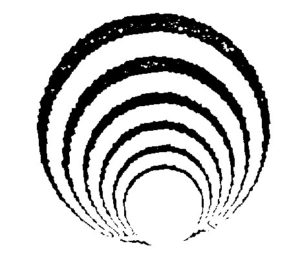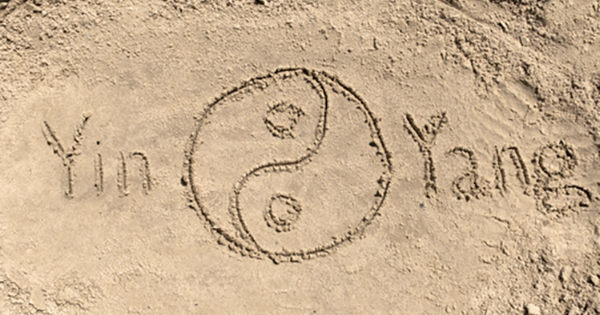More relevant to this article are receiving (or deflecting, intercepting, etc.) the blow with a circular or spiral motion, rotating or rolling the staff along its axis, and pivoting the staff around the point of contact. All three of these techniques add to the sticky quality of the staff by producing yin on one side of the point of contact while simultaneously having yang on the other side. With a staff, a practitioner can easily tell when they produce stickiness, rather than having the opponent’s staff bounce off.
While the rotating and pivoting described above for the staff can easily be visualized as what was described earlier for a ball’s actions at the point of contact, the receiving in a circular motion should be explained further. In the following illustration, multiple circles all contact one point near the bottom, which represents the point of contact with an opponent. Although circles are shown, these can also be viewed as being spheres (or balls), and there can be an infinite number of them of all sizes.

These circles can also be used to illustrate the infinite numbers of circular paths (in whole circles, or in parts as arcs) that a ball in contact with an opponent can take. Rather than merely rotating, the ball can also move in space. Since all of the circles share one common point (i.e. the point of contact with the opponent), the practitioner can instantly switch from any size circle/arc to any other size.
If you are moving along one circle, and you need to change directions, using the principle of the infinite sizes of circles all touching the point of contact will allow you to change to a tiny circle and smoothly continue in any other direction, even seemingly reversing directions, without coming to a stop. Likewise, you can change from a circle in one plane to any other plane if you keep in mind that the two-dimensional circles shown in the previous illustration can represent three-dimensional spheres.
Moving the point of contact through space can be represented with the following illustration:

[In the above illustration, the dot represents the point of contact.
The arrow represents the direction of movement.]
This illustration can also represent changing the point of contact by sliding (or smearing) across your or your opponent’s body [i.e., having their point of contact remain the same while changing yours, or having your point of contact remain the same while changing theirs, respectively]. This is another way of using stickiness to influence and control the opponent.
Zhang Yun, in his article on “random circles” states: “Random circles are dynamic, not static. Circles should be kept rolling and changing smoothly and naturally, never ending. An individual’s Taiji skill level can be judged by the random circles performance. The more circles are involved and the more changing can be done, the higher the skill level.”
[see http://www.ycgf.org/Articles/RandomCircles_in_TJQ/RandomCircles_1.html]
Creating and maintaining spherical energy at the point(s) of contact with an opponent can help to produce the “random circles” discussed in Zhang’s article.
The center of the sphere, which stays stable and still even when the sphere rotates, can also be related to the principle of stillness within motion. This is perhaps best illustrated using the ancient version of the Taiji diagram. The clear center pivot point represents stability within the cycling yin and yang energies.
While the arms have the mobility to express spherical energy when in contact with an opponent, the torso is more limited in its freedom of movement. Many treat the torso’s actions more like a cylinder than a sphere, since the horizontal circle produced by the rotation at the hips is the most prominent.
Although it is too difficult to describe clearly and concisely, and will not be expanded on in this article, there is a vertical cycle in the torso that can help to produce the three dimensional (spherical) energy. Briefly, this cycle is produced by energy sinking down the front of the torso and rising up the back.
The above information shows the complexity of applying what is, in essence, a fairly simple concept, that of maintaining yin on one side of the point of contact and simultaneously having yang on the other side. Though simple enough to understand intellectually, it is very difficult to put into practice, especially against an uncooperative opponent. Thinking of having the energy of a sphere at the point(s) of contact with an opponent can help in generating and differentiating yin from yang when practicing or applying interactive Taijiquan.

Leave a Reply